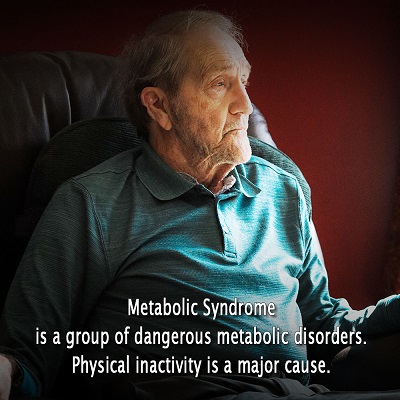 If you find yourself sitting all day on the couch or in front of the computer, not having the time, or making the time to exercise, then you are setting yourself up for some serious health issues long term.
If you find yourself sitting all day on the couch or in front of the computer, not having the time, or making the time to exercise, then you are setting yourself up for some serious health issues long term.
Physical inactivity and sedentary behavior can lead to various health issues, one of which is metabolic syndrome. This is important to be aware of because it can lead to serious and chronic illnesses.
Metabolic Syndrome Explained
Metabolic syndrome refers to a group of metabolic disorders, including elevated blood pressure, obesity, dyslipidemia, high blood sugar, excess fat around the waist, and abnormal cholesterol levels.
Several factors can increase your chances of developing metabolic syndrome, including extended physical inactivity, or sedentary behavior. Your age and ethnicity, along with other existing diseases are also contributing factors. People who are highly sedentary are more likely to develop metabolic syndrome.
It’s a chain reaction. Sedentary behaviors that result in a lack of physical activity can make you obese. Insulin helps sugar enter your muscle cells and burn it as fuel. With insulin resistance, sugar can’t enter the cells as effectively as it should, resulting in persistently high levels of blood sugar.
When you’re obese, your body is less sensitive to insulin, which means your body has a hard time using and therefore reducing blood sugar. When you develop metabolic syndrome, it can lead to increased risks of type 2 diabetes and heart diseases. Worse, it can also cause premature death.
Why Physical Activities are Important in Preventing Metabolic Syndrome
We know that exercise is important, yet many people still don’t bother to get up and exercise. It’s only when they experience health problems and are advised medically to do something about it, or suffer the consequences, that they do.
A lack of physical activity can increase insulin resistance and abdominal fat, leading to metabolic syndrome. Physical activities play an important role in preventing and treating metabolic syndrome. It’s also necessary to understand your underlying risk factors so you can identify targeted intervention through physical activities.
Metabolic syndrome can cause inflammation in the body, and most of the time, that makes engaging in physical activities less desirable and even painful. However, for the sake of your health and your longevity, you must overcome that resistance physically and psychologically.
Exercise can provide many of the benefits needed to help prevent metabolic syndrome.
Here are some of those benefits of exercise:
- It regulates body fat and glucose metabolism.
- It increases insulin sensitivity.
- It lowers blood pressure.
- It increases muscle mass.
- It burns calories faster even when at rest.
- It helps reduce weight.
- It improves lipid disorders.
- It helps you sleep better.
How You Can Prevent Metabolic Syndrome with Exercise
Combating physical inactivity and overcoming sedentary behaviors are key to fighting metabolic syndrome.
If you’re transitioning from a complete lack of physical activity and a longtime sedentary lifestyle, starting with small changes is important. Begin with light exercises then move to moderate intensity.
Moderate exercises are sufficient enough to help reduce your risks of metabolic syndrome. However, you may want to do increased amounts of vigorous exercise too to see the biggest improvements.
Just remember not to go too hard too soon. It may shock and harm your body, especially your heart, if you’ve been sedentary for too long and then suddenly engage in extreme physical activities.
Get Up and Start Now
Get up, start exercising, and be consistent. Stay committed to your program and know that every little movement that you do matters. Start by walking each day and remember to take as many breaks as you need.
Once you have integrated exercise into your routine comfortably, increase the duration over time and then increase intensity. Ideally, you should be able to get to a point where you can exercise for at least 30 minutes on most days of the week.
It also helps to track your progress. Use a pedometer or your smartphone’s health app. Set goals! How many steps per day do you want to walk? You may have heard of walking 10,000 steps a day. If that sounds like a good goal for you, why not try to achieve it every day.
Don’t forget to celebrate your milestones. It will keep you motivated and committed to your goal of saying goodbye to a sedentary lifestyle and removing the risks of metabolic syndrome.





